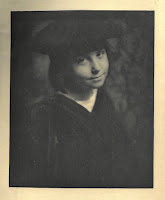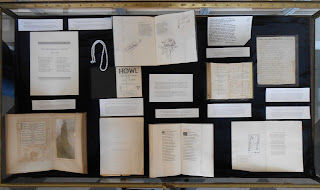 This last week, Rauner welcomed art history professor Katie Hornstein's History of Photography class for an hour-long romp through some of the most amazing books related to photography. Some of the gems included Gardner's Sketch Book of the Civil War and autographed prints by Margaret Bourke-White that were published in Erskine Caldwell's You Have Seen Their Faces. Another beautiful work that the students explored was Camera Work, a photography journal edited by Alfred Stieglitz that ran from 1903 through 1917.
This last week, Rauner welcomed art history professor Katie Hornstein's History of Photography class for an hour-long romp through some of the most amazing books related to photography. Some of the gems included Gardner's Sketch Book of the Civil War and autographed prints by Margaret Bourke-White that were published in Erskine Caldwell's You Have Seen Their Faces. Another beautiful work that the students explored was Camera Work, a photography journal edited by Alfred Stieglitz that ran from 1903 through 1917. Alfred Stieglitz is often credited for the eventual acceptance of photography as an legitimate art form in the 20th century. He was also known as a promoter of modern art and ran several New York art galleries and was the husband of artist Georgia O'Keeffe. Shortly after 1902 Stieglitz founded a movement called the Photo-Secession that disavowed all traditional definitions of what constituted a photograph. This included a rejection of the oppressive control that contemporary institutions, galleries, and art schools had over the determination of what could and could not be considered art.
Alfred Stieglitz is often credited for the eventual acceptance of photography as an legitimate art form in the 20th century. He was also known as a promoter of modern art and ran several New York art galleries and was the husband of artist Georgia O'Keeffe. Shortly after 1902 Stieglitz founded a movement called the Photo-Secession that disavowed all traditional definitions of what constituted a photograph. This included a rejection of the oppressive control that contemporary institutions, galleries, and art schools had over the determination of what could and could not be considered art. Camera Work was a vehicle for promoting this movement by showcasing the work of the Photo-Secessionists, primarily through high-quality photogravure reproductions of film positives that had been transferred to a copper plate. Stieglitz's insistence on perfection in these reproductions was such that, at least in one instance, the photogravures were hung in a gallery exhibition instead of the actual prints, whose delivery had been delayed.
Camera Work was a vehicle for promoting this movement by showcasing the work of the Photo-Secessionists, primarily through high-quality photogravure reproductions of film positives that had been transferred to a copper plate. Stieglitz's insistence on perfection in these reproductions was such that, at least in one instance, the photogravures were hung in a gallery exhibition instead of the actual prints, whose delivery had been delayed.At Rauner, we are fortunate to have a complete run of Stieglitz's groundbreaking publication. To see more of the stunning photogravures in any of Rauner's fifty volumes (in twenty-four issues), come to the reference desk and ask to see Rare TR1 .C5.
